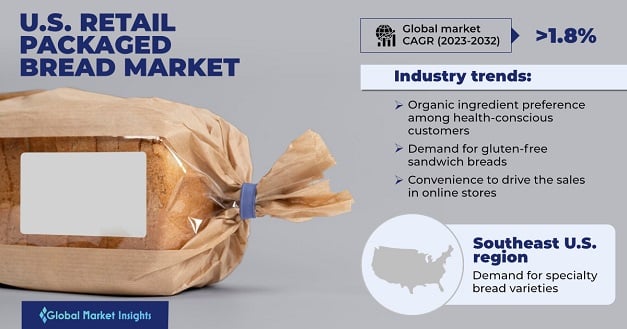Home > Food & Beverages > Processed Food > Baked Goods > U.S. Retail Packaged Bread Market
U.S. Retail Packaged Bread Market Size
- Report ID: GMI4487
- Published Date: Oct 2023
- Report Format: PDF
U.S. Retail Packaged Bread Market Size
U.S. Retail Packaged Bread Market size is estimated to grow at over 1.8% CAGR from 2023 to 2032, attributed to the increasing demand for convenient and ready-to-eat food products in the nation. Busy lifestyles and a growing preference for on-the-go meals have driven consumers to opt for packaged bread, which offers convenience and longer shelf life.

Moreover, health-conscious consumers are seeking healthier alternatives, and this has spurred the demand for whole grain and artisanal bread varieties. As consumers become more health-conscious and prioritize nutritional aspects, the bread manufacturers are responding with a wider range of options, including gluten-free and low-carb bread variants. For instance, the Vermont based American supplier of baking goods, King Arthur Baking Company, launched Gluten-Free Bread Flour at Natural Products Expo West in March 2023, enabling bakers to create gluten-free treats with the taste, texture, and rise of traditional baked goods.
| Report Attribute | Details |
|---|---|
| Base Year: | 2022 |
| Forecast Period: | 2023 to 2032 |
| Forecast Period 2023 to 2032 CAGR: | 1.8% |
| Historical Data for: | 2018 to 2022 |
| No. of Pages: | 124 |
| Tables, Charts & Figures: | 116 |
| Segments covered: | Product, Ingredient, Recipe, Distribution Channel, and Region |
| Growth Drivers: |
|
| Pitfalls & Challenges: |
|
Similar efforts by other baking companies and food product manufacturers, along with the numerous innovations in packaging to enhance product freshness with continue to create growth prospects for the U.S. retail packaged bread market.
The concerns about health and nutrition have led to a decline in demand for traditional white bread, necessitating constant innovation to cater to changing dietary preferences. Additionally, with fluctuating wheat prices and supply chain disruptions, the production costs and pricing strategies keep changing. All these factors, along with sustainability concerns pertaining to the plastic packaging, and high R&D costs for innovating eco-friendly packaging solutions are acting as challenges, which may restrain the market expansion.
